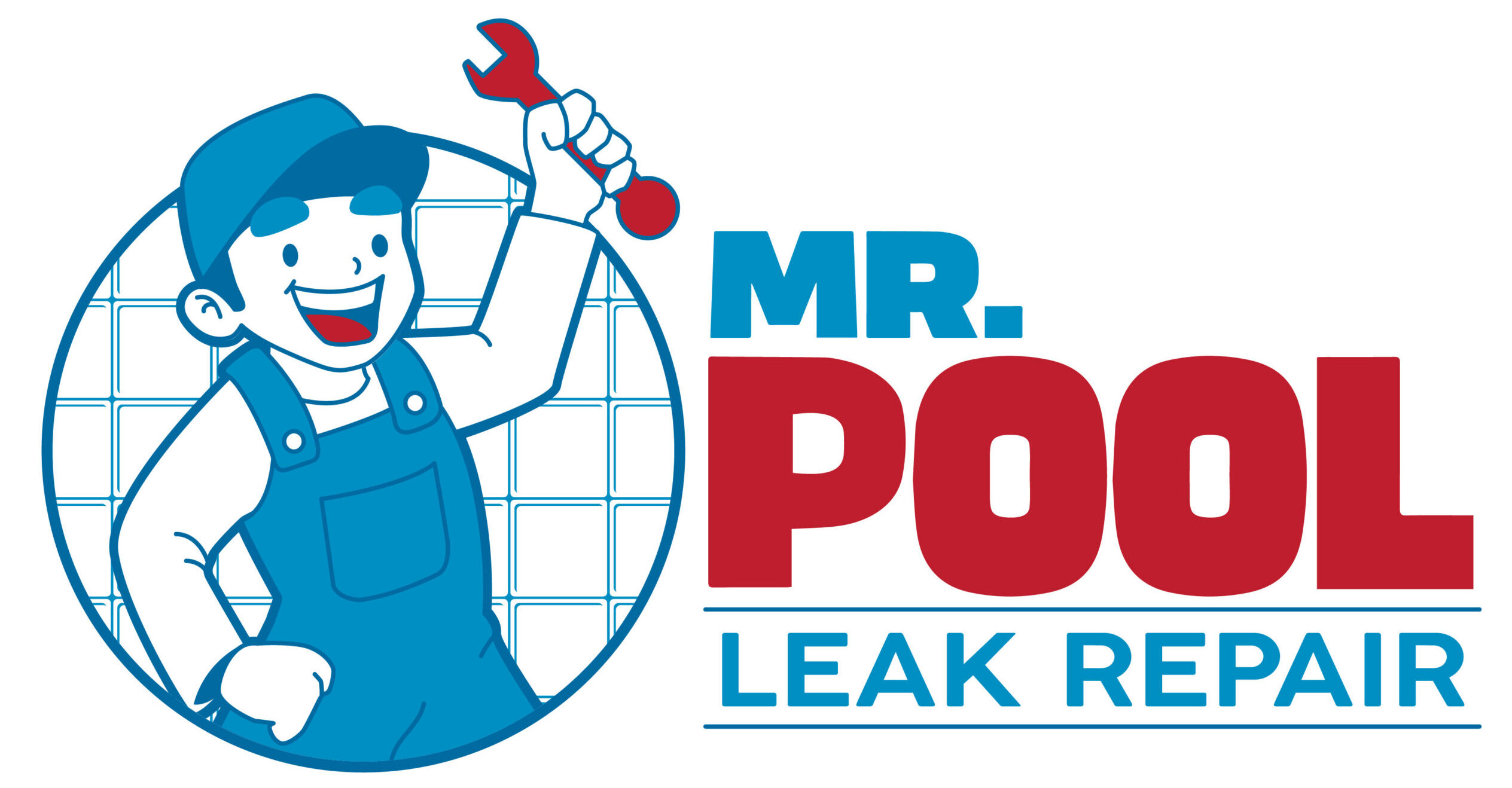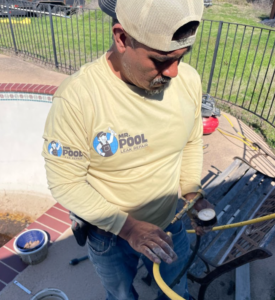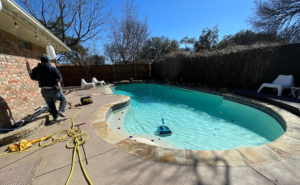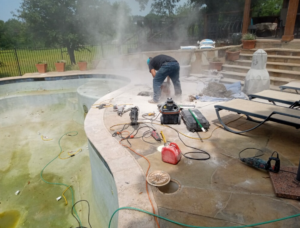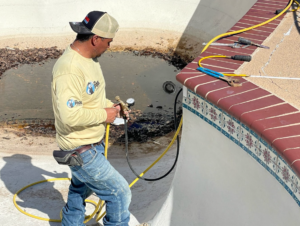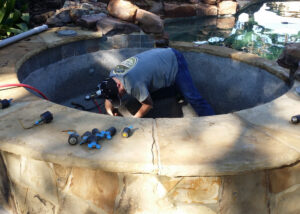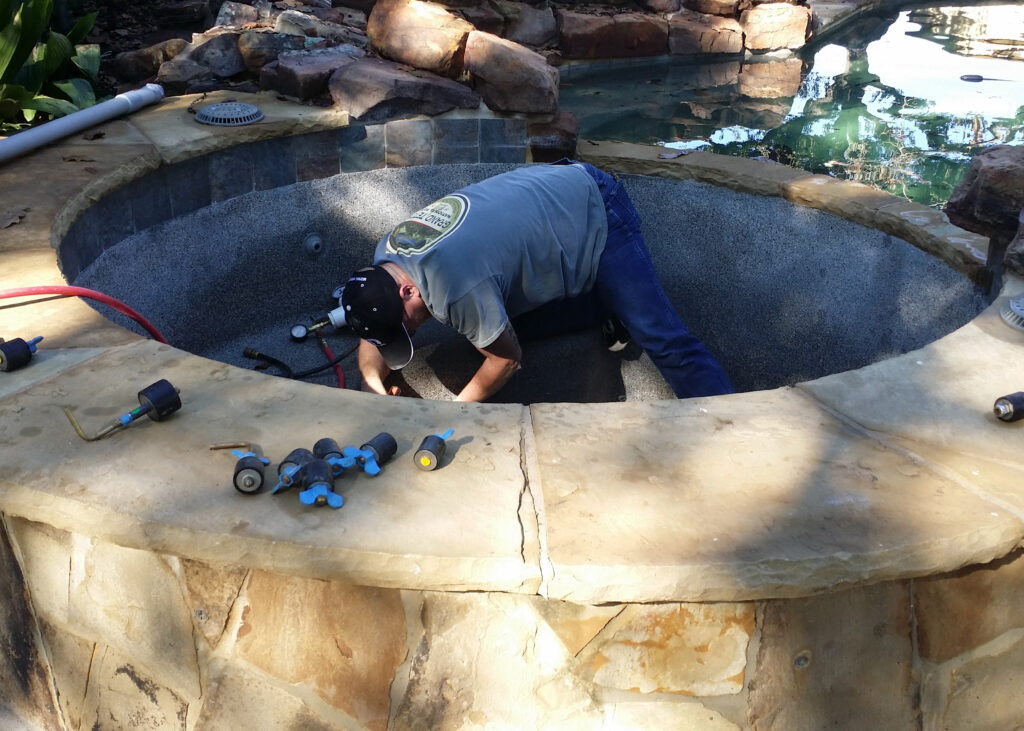
You may be wondering if you have a swimming pool leak if you notice that the water level is dropping more quickly than normal. It’s time to begin troubleshooting if you see wet spots around the pool, or near the equipment pad. With a little knowledge and the right leak detector tools, it’s easy to locate most pool leaks. You can repair many swimming pool leaks yourself once you have found the source. This blog post will walk you through three simple steps to repair a pool leak, focusing on effective swimming pool leaks repair techniques. Whether you’re dealing with minor issues or more significant repairs, understanding how to approach swimming pool leaks repair can save you time and money.
Contact Us
1. Recognize Signs of Pool Leakage
2. Find the exact location of the leak
3. How to Fix a Pool Leak
Step 1: Recognize Signs of Pool Leak
The first step in repairing a pool leak is to identify it. Leaks in pools often begin as minor drips. If not dealt with quickly, they can grow into a larger problem.
Every drop of water that leaks from a pool is a waste, as it can be filtered, heated, or even treated. They can cost you much more than water, chemicals, and energy. Low water levels can also cause the motor to overheat. Concrete slabs can shift and crack if there are leaks underneath the pool deck or equipment pad. Vinyl pools can have their liners pucker up and start to pull away from the walls. Keep an eye on your pool to prevent costly damage.
In the diagnosis stage, you should be aware of any water loss due to evaporation or splashout. Be sure to include water gained from rain and other natural sources. Turn off all automatic filling or water-leveling devices when you suspect a pool leak.
Bonus tip: Leaks don’t only affect inground pools. Above-ground pool leaks may soften the soil around the pool’s edge, causing it to move, wrinkle or even fail. Long-term exposure to wet ground can cause corrosion and rust to the steel supports and walls of your pool.
The Wet Zones Around the Pool Pad or Equipment Pad
Slowly walk around the perimeter of the pool looking for any areas with standing or moist water. Is there running water further away, particularly downhill? You can help yourself by knowing which side of the swimming pool has underground plumbing. Let me reassure you that a leak in a swimming pool is rarely found in underground pipes. The leak will likely be somewhere else unless the ground has moved significantly or you have had a harsh winter. Most underground leaks occur under the equipment pad, where the pipes are vertical, or near the drain, skimmer or return pipes.
Check the area where the filter and pump are located. Look for standing water, erosion or wet areas. Note any drips from pipes and equipment. Remember, if your water loss is significant (more than several gallons an hour), it’s likely that the leak originates elsewhere. Even slow drips that are above ground need to be addressed. These drips are unlikely to cause major water losses. There is one leak on the equipment pad which could result in a significant loss of water. D.E. On D.E. When the backwash hose leaks water while the valve is in the filter position, it is time to replace or repair the valve.
Eliminate Evaporation
Evaporation can cause a pool to lose up to 1.5″ to 2 ” of water each week in hot weather. Evaporation rates are affected by sun exposure, humidity and wind speed. Do the bucket test to determine if there is a leak, or evaporation. Use a Mini Bucket Test or conduct your own test with a 5-gallon clean bucket.
Avoid doing the bucket test in bad weather conditions or during periods of high winds. This can affect the results. Turn off all automatic filling devices to avoid adding water during the test.
Set your container of water on the pool step. Fill it up with water until the level inside matches the level outside. You can use a tape or a marker to mark the level of water on the container. In a few days, check back to see if the water levels have changed. You will know if you have a leak if the water in the container is greater than the outside level. If the levels of water are equal, it is evaporation.
Step 2: Find the exact location of the leak
After you have confirmed the existence of a leak in your pool, it is time to find out where it is. Begin with general troubleshooting and then work your way to the exact location.
Common Pool Leaks
When you are troubleshooting the leak to locate the approximate location, keep in mind these common sources of leaks.
Skimmer Leaks
A skimmer for vinyl pools is secured with two gaskets and a faceplate. There are also about 12 screws. The skimmer for concrete pools is enclosed in concrete and plastered. Leaks are common at the interface between the skimmer and pool because the plastic skimmer flexes and expands differently from the concrete. You can look for cracks around the skimmer’s entrance and those tiny pieces of debris that get sucked in the cracks.
Pool Liner Leaks
The pool liner may leak at any point. Vinyl liner leaks are most likely to occur around areas where the vinyl is stretched out (walls and corners), or in areas which are gasketed. Check that the faceplate screws on the liner are tight. If the leak persists after you have plugged up all lines, the problem may be due to a loose screw. Use goggles or snorkel masks to inspect the liner under water.
Pool Light Leaks
The conduit for underwater lighting may leak water if it is not winterized. It can also be caused by shifting soil. Leaks in pool lights are difficult to detect and cannot be detected with dye tests. If you see that the water level in your pool drops up to the top of the lights and then stabilizes, this could be a sign that there is a problem.
Pool Plumbing Leaks
Underground pipes can leak. As we have already mentioned, underground plumbing leaks are rare. Most pool leaks occur just below the equipment pad where the pipes become vertical. Due to soil or ground movement, pipes can also come loose directly below the drain, skimmer or return pipe.
Contact Us
Noticeable water loss at Specific Times
Is the pool still leaking when the pump is turned off? Does it only happen when the pump is running or does it leak at all times? These questions, while they may seem general, can help you find the answer.
You may have a filter valve leak (sand or D.E.). This can lead to the return or backwash lines (cracks will expand under pressure). It could be a suction line leak (skimmer or main drain) if it only leaks with the pump off. You may notice that air is also entering the pump basket in this situation. The same cracks which draw in air when the vacuum is on will leak water after the pump stops and the pressure has been released. If the pool is always leaking, it could be that the problem is with the pool shell and not the plumbing. Remember that a swimming pool can have multiple leaks!
The next step to rule out any plumbing leaks is to shut off the pump and all skimmers. You may have already purchased plugs for pools that are winterized. If you don’t have the right size plugs, purchase them to fit your returns and skimmer. Due to the difficulty, it is rare for the main drain to be plugged. Keep the pump off while you install the plugs!
If the leak persists after the pipes have been plugged up, it is possible that the leak may be in the shell. It could be around the face of a skimmer, or a underwater pool light. Check that the vinyl pool’s faceplates and vinyl liner are tightly fastened. If you suspect a leak, dye-test it.
The pool stops leaking or the water level stabilizes
Have you allowed the water to drop to a point where it appears to be stabilizing? Most people don’t do this because they are afraid of the water falling below the skimmer when the pump is running. This test can confirm if the leak is in the pool lights or skimmer.
Important: Do not continue this test if you suspect the leak to be deeper than 12-18″ or if it does not appear that the water will stop at that depth. Fill the pool with water to the appropriate level and then continue troubleshooting using other methods, or consult a professional. The pool’s structure or vinyl liner can be damaged if you allow it to drain too much.
Close the skimmer and main drain valves if you have separate lines for the drain and the skimmer in front of your pump. Keep the main drain open. It may be necessary to plug skimmers to prevent air from entering the pump if older valves leak. You can use a hose with an adapter to connect a vacuum hose to the skimmer if you do not have a separate drain valve. You can also balance the pool and then super-chlorinate it, before turning off the pump. This method is useful if your pool does not have a main drainage line.
Test for Leaks with Dye
A dye test can be used to find the exact location of the leak or to confirm your suspicions. Turn off the automatic filling devices and the pump so that there is no water. You can also use a snorkel or goggles to see clearly underwater.
Apply a small amount of dye directly next to the area where you think there is a leak. You’ve confirmed the location of the leak if you see the dye being sucked into the area. Now you can move onto the next step. It’s a common misconception that you can squirt dye around the area to find the leak, but this is not true. You need to apply the dye right next to the suspected leak within 1/4″ or even less.
Advanced Leak Detection
You stumped by simple troubleshooting methods? It may be necessary to use advanced methods of pool leak detection. Professionals will use advanced tools and methods to diagnose pool leaks quickly and accurately. You can also get advice on repairs and next steps.
You can narrow down the location of a leaky pipe by pressure testing it. Water or air is pumped into the pipes to test for leaks. Leak detection professionals can pinpoint leaks using air and listening devices. They then draw an “X” in the ground.
Step 3: Repair the pool leak
Simple Pool Leak Repairs
Once found, most pool leaks can be easily repaired. Most simple repairs require a little pool putty or waterproof silicone. They may also include a vinyl patch or plaster patch. Pentair Stop Leak can be used to patch up very small plumbing leaks, but it is not a good solution for larger plumbing leaks.
If your pool light is leaking, you can use pool putty to seal the cord at the exit of the niche or spray a sealant such as Underwater Magic in the conduit.
You may be able find the replacement parts you need online if your leak is due to a bad gasket, a damaged o-ring, or a cracked part. Some of the most commonly needed pool parts for leak repairs are skimmer gaskets, filter valve components and o-rings.
Patch may help you fix a crack caused by a structural flaw in concrete or plaster.
Repairing Complex Pool Leaks
A portion of the pool deck may have to be removed for the most difficult leak repair. If there are cracks in the tile, it may be necessary to replace the tile and coping to repair the beam.
If extensive freezing damage or old age cause major leaks, an underground pipe can be abandoned and replaced or not. Professionals can guide you to the best option for your budget, and long-term health of your swimming pool. If you own a vinyl pool, it may be necessary to purchase a new liner to repair a leak.
Benefits of Choosing Mr. Pool Leak Repair
When you choose Mr. Pool Leak Repair for your pool leak detection and repair needs, you gain access to a range of benefits that set us apart from the competition:
Expertise and Experience:
With years of experience in pool leak detection, Mr. Pool Leak Repair has built a reputation for excellence throughout Texas. Our team of skilled technicians has encountered a wide range of pool issues, making us well-equipped to handle any situation that arises.
Cutting-Edge Technology:
We continually invest in the latest technology and tools to ensure the most accurate and efficient pool leak detection process. This commitment allows us to save you time and money by quickly identifying and repairing leaks.
Minimized Disruption:
Our non-invasive methods for leak detection help minimize disruption to your property. You can enjoy your pool without the hassle of extensive excavations or prolonged repairs.
Cost-Efficient Solutions:
By detecting leaks early and providing prompt repairs, we help you save on water bills, pool maintenance, and potential structural damage costs in the long run.
Environmentally Conscious:
At Mr. Pool Leak Repair, we understand the importance of conserving water in Texas. Our leak detection and repair services contribute to water conservation efforts, benefiting both you and the environment.
